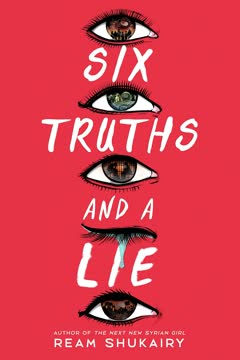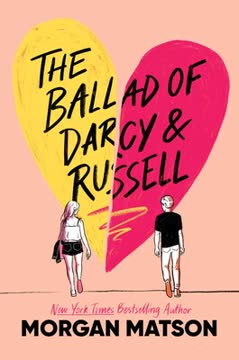Plot Summary
Prom Night Reckoning
Hannah MacLaren, caught in the aftermath of pulling the fire alarm at prom, faces the Head of School and the threat of expulsion. The night's chaos is a culmination of grief, secrets, and a desperate need for answers about her cousin Sophie's death. As accusations fly and friendships fracture, Hannah is forced to confront the tangled web of lies she's spun at her elite private school. The emotional weight of the year—her cousin's overdose, her own isolation, and the relentless search for truth—crashes down, leaving her future uncertain and her relationships in shambles. In this crucible moment, Hannah's choices will define not only her senior year but the legacy of the girl she loved and lost.
Two White Dresses
The story rewinds to the summer before everything fell apart, when Hannah and Sophie are inseparable. Their bond is symbolized by two white dresses—one for a country club fundraiser, the other for a cotillion Sophie dreads. Through art museums, thrifted lunches, and family banter, their differences and deep love are revealed. Sophie's optimism and activism contrast with Hannah's cynicism and drive. The chapter sets the emotional stakes: Sophie is the sun around which Hannah orbits, and the world feels safe and full of possibility. But beneath the surface, pressures—family expectations, college ambitions, and the first hints of pain—begin to gather, foreshadowing the storm to come.
Grief's First Year
After Sophie's sudden death from an opioid overdose, Hannah's world is gutted. Grief is raw, physical, and isolating. She cycles through denial, anger, and bargaining, haunted by what-ifs and the impossibility of moving on. The funeral and its aftermath expose the inadequacy of comfort and the chasms between mourners. Hannah's relationships with her mother, best friend Lincoln, and Sophie's other best friend Gabi are strained and reconfigured. The pain is compounded by the mystery of Sophie's last night—how could someone so full of life be gone, and how could Hannah not have known? The year becomes a blur of survival, with the promise to find answers burning at its core.
The Investigation Begins
Unable to accept Sophie's death as a tragic accident, Hannah and Gabi secretly join forces to investigate. They pore over texts, party photos, and social media, building lists of suspects and timelines. The search is methodical but desperate, driven by the need to assign blame and reclaim agency. Each clue—burner phone messages, mysterious party guests, and the absence of Sophie's journal—deepens the mystery. The investigation becomes an obsession, a way to channel grief into action. But it also breeds paranoia, secrecy, and the risk of self-destruction, as Hannah's world narrows to the hunt for the truth.
New Girl, New Lies
Hannah transfers to Sophie's private school, Ingleside, seeking both a fresh start and proximity to the truth. She crafts a new identity—blond hair, a Vancouver backstory, and a carefully constructed persona. She befriends Zoe, Warner, Brooks, and others, all while hiding her connection to Sophie and her real motives. The school's privilege and insularity are both a shield and a prison. Hannah's double life is exhausting, and the pressure to maintain her cover grows as she gets closer to her classmates and the investigation. The cost of deception mounts, threatening her sense of self and the fragile new bonds she's formed.
The List Narrows
As Hannah and Gabi's investigation progresses, the list of possible culprits shrinks. Each suspect—Brooks, Ben, Barrett, and the mysterious "arm person"—is scrutinized through interviews, surveillance, and social engineering. Rivalries with Christian Dailey, Hannah's debate nemesis and reluctant ally, add complexity and emotional charge. The search for Sophie's journal and the analysis of party evidence bring moments of hope and despair. The girls' methods grow riskier, and the lines between justice and vengeance blur. The truth seems tantalizingly close, but every answer raises new questions and moral dilemmas.
Rivalries and Revelations
Hannah's relationship with Christian Dailey evolves from antagonism to uneasy partnership, and eventually, something more. Their shared history—misunderstandings, betrayals, and mutual respect—mirrors the larger themes of the story: the difficulty of trust, the pain of growing up, and the possibility of forgiveness. As secrets are revealed—about Christian's own grief, Gabi's guilt, and Hannah's motivations—the characters are forced to confront their own flaws and the limits of their knowledge. The investigation's emotional toll becomes clear, and the need for connection and honesty grows more urgent.
The Gala Gambit
The So Far Foundation gala, organized in Sophie's memory, becomes the stage for Hannah and Gabi's boldest move. They send anonymous messages to their top suspects, hoping to force a confession or at least a sign. The event is charged with emotion, as families, friends, and classmates gather to mourn and celebrate Sophie. The plan backfires—multiple suspects respond, and the truth remains elusive. The night exposes the limits of their control and the complexity of guilt and responsibility. It also marks a turning point, as the girls' partnership fractures under the weight of secrets and differing visions of justice.
Fractures and Forgiveness
The fallout from the gala and the investigation's failures leads to painful confrontations. Gabi confesses her own complicity and guilt, shattering Hannah's trust. Lincoln, Hannah's childhood friend, calls her out for her emotional distance and self-destructive choices. Hannah is forced to reckon with the ways she's hurt those around her, and the impossibility of perfect closure. Yet, through honest conversation and shared vulnerability, the possibility of forgiveness emerges. The characters begin to accept that healing is messy, nonlinear, and requires both accountability and grace.
The Final Suspects
With the list narrowed to Brooks and Ben, and the mysterious "arm person" identified, the investigation reaches its climax. A series of revelations—Zoe's connection to Ben, Brooks's confession, and the role of privilege and parental complicity—bring clarity and heartbreak. The truth is not simple: Sophie's death was the result of a web of choices, pain, and systemic failures. The final confrontation is less about punishment and more about understanding, support, and the hope for recovery. The cost of the search is high, but the burden of silence would have been higher.
Prom Night Fallout
The events of prom night—Hannah's exposure, the planted pills, and the fire alarm—force the truth into the open. Friendships are tested, reputations are shattered, and the school community is rocked by scandal. Hannah faces suspension, public shame, and the loss of trust from those she cares about. Yet, in the aftermath, there is also relief: the end of secrecy, the possibility of real healing, and the chance to rebuild on honest ground. The story's emotional arc reaches its nadir, but the seeds of hope are planted.
Truth and Consequences
As the dust settles, the characters grapple with the aftermath of revelation. Brooks enters treatment, supported by friends and family. The school and community reckon with their roles in enabling silence and stigma. Hannah, Christian, Gabi, and others must decide what kind of future they want to build—one defined by blame, or by compassion and action. The story refuses easy answers, acknowledging the complexity of addiction, grief, and responsibility. The focus shifts from retribution to harm reduction, support, and the ongoing work of change.
Building Eleventh House
Ginny, Sophie's mother, channels her grief into the creation of 11 Caldwell, a recovery house for students. The dedication ceremony becomes a moment of collective mourning and hope, as Hannah delivers a speech that honors Sophie's complexity and calls for empathy and action. The house symbolizes the possibility of transformation—of pain into purpose, and loss into legacy. The community gathers, fractured but striving, and the characters begin to imagine a future where support and understanding replace shame and silence.
Letting Go, Moving Forward
As graduation approaches, Hannah and her friends reflect on the journey they've taken. Relationships are mended, new paths are chosen, and the weight of grief is lightened, if not erased. The story's lessons—about the necessity of connection, the dangers of secrecy, and the power of collective action—are embodied in the characters' choices. Letting go does not mean forgetting; it means carrying forward what matters and allowing for new beginnings. The future is uncertain, but hope is possible.
Graduation and Goodbyes
Graduation day is both an ending and a beginning. Hannah, Gabi, Christian, and the others celebrate their achievements, mourn what's been lost, and look ahead to what's next. The bonds forged in pain and struggle endure, even as the characters scatter. The story closes with a sense of hard-won wisdom: that healing is ongoing, that love persists, and that the work of building a better world—one where no one is left alone in their pain—continues. Sophie's memory is honored not by vengeance, but by the lives her friends choose to lead.
Characters
Hannah MacLaren
Hannah is the novel's protagonist, a fiercely intelligent and driven girl whose life is upended by her cousin Sophie's overdose. Her need for answers is both a coping mechanism and a compulsion, leading her into deception, obsession, and moral gray areas. Hannah's relationships—with her mother, best friend Lincoln, rival-turned-love Christian, and co-investigator Gabi—are marked by intensity, loyalty, and frequent conflict. Psychologically, she is defined by her fear of abandonment, her struggle with vulnerability, and her tendency to push people away when things get hard. Over the course of the story, Hannah learns the limits of control, the necessity of forgiveness, and the power of community. Her arc is one of hard-won growth: from isolation and vengeance to acceptance and hope.
Sophie Abbott
Sophie is the story's absent center—a vibrant, idealistic, and deeply loved girl whose death reverberates through every character. In life, she was a connector, activist, and source of joy; in death, she becomes a symbol of both possibility and tragedy. Sophie's struggles with pain, pressure, and hidden melancholy are gradually revealed, complicating the narrative of innocence lost. Her relationships—with Hannah, Gabi, her family, and her school—are marked by both closeness and secrecy. Psychologically, Sophie embodies the contradictions of adolescence: strength and vulnerability, hope and despair. Her legacy is not just the mystery of her death, but the community and change her memory inspires.
Gabi Reyes
Gabi is Sophie's other best friend and Hannah's partner in the search for truth. Analytical, perceptive, and quietly ambitious, Gabi is both a mirror and a foil to Hannah. Her own guilt over missing signs of Sophie's addiction drives her to obsessive investigation and, eventually, to confession and reconciliation. Gabi's relationships—with her family, Catherine, and Hannah—are shaped by her need for control and her fear of being blamed. Psychologically, she is marked by a deep sense of responsibility and a struggle to balance idealism with pragmatism. Gabi's arc is one of self-forgiveness and the recognition that healing requires both honesty and letting go.
Christian Dailey
Christian is Hannah's debate nemesis, whose sharp intellect and moral certainty both infuriate and attract her. Their relationship evolves from antagonism to partnership to romance, mirroring the story's themes of trust, vulnerability, and the possibility of change. Christian's own grief—his mother's death, his outsider status at Ingleside—parallels Hannah's, creating a bond beneath their sparring. Psychologically, he is driven by principle, a need to be right, and a longing for connection. His arc is one of learning to let go of control, to forgive, and to risk his heart.
Lincoln
Lincoln is Hannah's childhood best friend, a source of stability and comfort. His loyalty is unwavering, but he struggles with Hannah's emotional distance and self-destructive choices. Lincoln's own journey—navigating college, relationships, and the loss of his place in Hannah's life—reflects the pain of growing up and growing apart. Psychologically, he is grounded, empathetic, and quietly wounded by Hannah's choices. His role is to challenge her, to call her back to herself, and to remind her of the value of ordinary, enduring love.
Zoe Walsh
Zoe is Hannah's first real friend at Ingleside, a talented artist and class president whose intensity and honesty make her both intimidating and invaluable. Her own experiences with heartbreak, ambition, and the pressures of perfectionism parallel Hannah's struggles. Zoe's relationship with Hannah is tested by betrayal and secrecy, but ultimately becomes a model of forgiveness and growth. Psychologically, Zoe is self-aware, driven, and unafraid to confront uncomfortable truths. She represents the possibility of connection beyond shared trauma.
Brooks Van Doren
Brooks is one of the final suspects in Sophie's death—a popular, athletic boy whose charm masks deep pain and addiction. His complicity is both direct and systemic: he provides pills, is protected by his family's privilege, and is ultimately forced to confront the consequences of his actions. Psychologically, Brooks is marked by guilt, denial, and a longing for absolution. His arc is one of reckoning, confession, and the uncertain hope of recovery.
Ben Ashby
Ben is another suspect, a scholarship student and cross-country runner whose introversion and relationship with Violet make him an enigma. His late arrival at the party and ambiguous alibi keep him in the crosshairs of the investigation. Psychologically, Ben is reserved, loyal, and ultimately innocent of the central crime. His role is to complicate the narrative of guilt and to highlight the dangers of suspicion and assumption.
Ginny Abbott
Ginny is Sophie's mother, a former journalist who channels her pain into action by founding the So Far Foundation and 11 Caldwell. Her relationship with Hannah is complex—marked by love, misunderstanding, and the shared burden of loss. Psychologically, Ginny is resilient, driven, and capable of transformation. Her arc is one of moving from vengeance to compassion, and from mourning to building a legacy.
Catherine
Catherine is the editor of the school paper and Gabi's girlfriend, a photojournalist whose calm, competence, and integrity provide a counterpoint to the story's chaos. Her friendship with Hannah and Gabi is marked by discretion, support, and a commitment to truth. Psychologically, Catherine is grounded, principled, and quietly influential. She represents the possibility of doing good work in a broken world.
Plot Devices
Dual Timelines and Nonlinear Structure
The novel employs a dual timeline, alternating between Hannah's junior and senior years, to gradually unveil the mystery of Sophie's death and the evolution of Hannah's relationships. This structure allows for suspense, dramatic irony, and the layering of emotional context. Key events—prom night, the gala, the investigation's breakthroughs—are foreshadowed and revisited, deepening their impact. The nonlinear approach mirrors the process of grief and memory: fragmented, recursive, and always colored by new understanding.
Mystery and Red Herrings
The central mystery—who gave Sophie the pills?—drives the narrative, with clues, suspects, and false leads propelling the action. The investigation is both literal and metaphorical: a quest for justice, a way to process grief, and a means of self-discovery. Red herrings and shifting suspicions keep the reader (and Hannah) off-balance, while the ultimate revelation complicates notions of guilt and innocence. The device underscores the story's themes: the limits of knowledge, the dangers of certainty, and the necessity of compassion.
Parallel Character Arcs
The novel's major characters—Hannah, Gabi, Christian, Brooks, Ginny—undergo parallel arcs of loss, guilt, and growth. Their stories intersect and diverge, illuminating different responses to trauma and the possibility of forgiveness. The use of parallelism and contrast deepens the emotional resonance and highlights the interconnectedness of individual and collective healing.
Symbolism and Motifs
Recurring symbols—white dresses, Sophie's journal, the Eleventh House, the fire alarm—serve as touchstones for the characters' journeys. These motifs ground the story's abstract themes in concrete detail, providing continuity and depth. The symbolism of building (the recovery house), burning (the fire alarm, the bonfire), and transformation (haircuts, new clothes, graduation) reinforces the narrative's focus on change, loss, and renewal.
Ethical Dilemmas and Moral Ambiguity
The plot is driven by ethical questions: What does justice look like? Who deserves blame? When does the pursuit of truth become harmful? The characters' choices are rarely clear-cut, and the story resists simple resolutions. This ambiguity invites the reader to grapple with the same questions, fostering empathy and critical reflection.
Analysis
All That's Left to Say is a powerful exploration of what happens when tragedy strikes a close-knit community and the people left behind are desperate for answers. Emery Lord deftly captures the psychological complexity of grief—its anger, guilt, and longing for meaning—while refusing to offer easy solutions. The novel interrogates the allure and danger of obsession: Hannah's relentless search for the truth is both a lifeline and a trap, threatening to consume her and those she loves. The story is also a critique of privilege, institutional failure, and the ways in which systems protect the powerful at the expense of the vulnerable. Yet, at its heart, the book is about connection: the necessity of honesty, the courage to forgive, and the possibility of building something new from the ashes of loss. Lord's nuanced characters, sharp dialogue, and layered structure invite readers to reflect on their own responses to pain and injustice. The ultimate lesson is that healing is not found in vengeance or certainty, but in community, compassion, and the willingness to keep moving forward—even when the path is unclear.
Last updated:
Review Summary
All That's Left to Say receives mixed reviews, with an average rating of 3.68/5. Many praise Lord's writing style and emotional depth in exploring grief, addiction, and family dynamics. The dual timeline structure divides readers, some finding it compelling while others find it confusing. Readers appreciate the realistic portrayal of characters and the mystery element. Some criticize the pacing and character likability. Overall, the book is recognized for its poignant exploration of loss and healing, though opinions vary on its execution.







